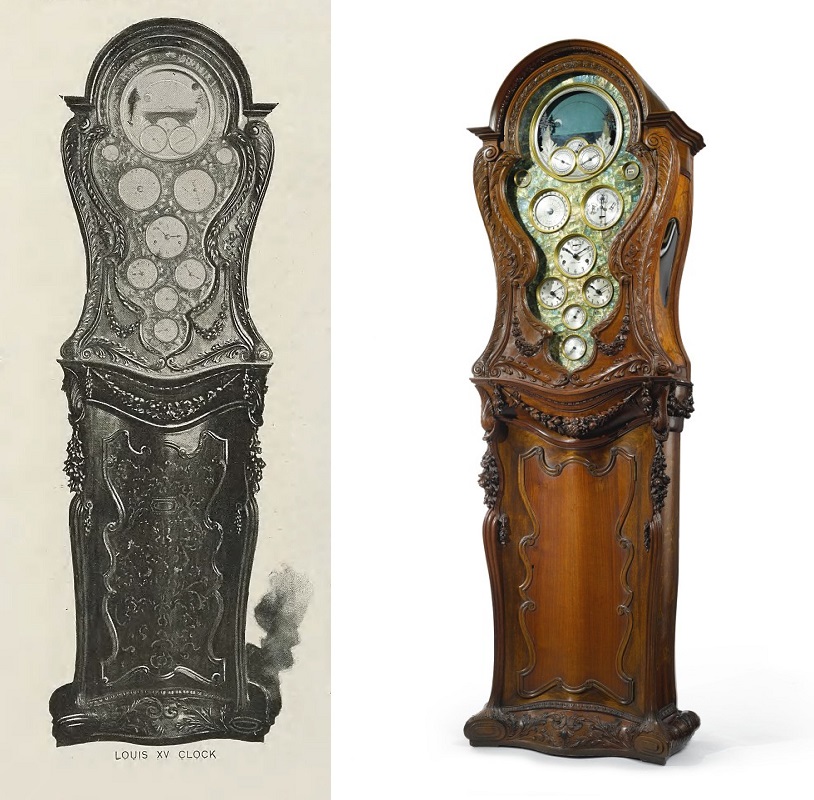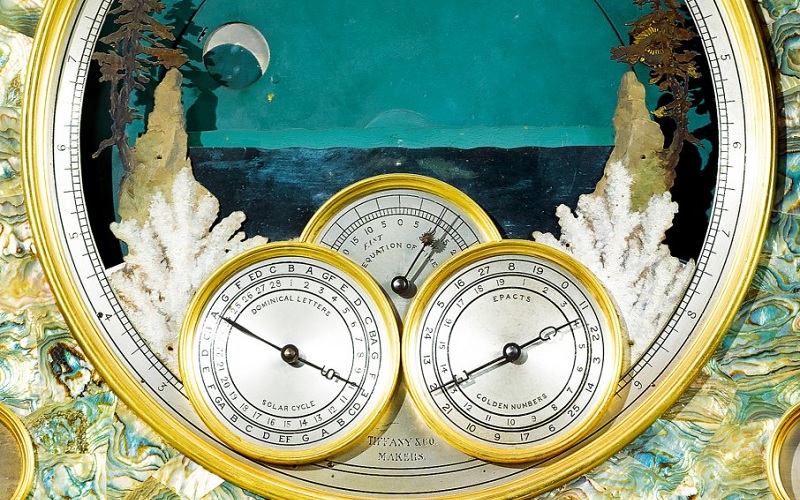
(Left) The “Louis XV Clock” on display in the Tiffany Pavilion within the Manufactures and Liberal Arts Building. [Image from Bancroft, Hubert Howe The Book of the Fair. The Bancroft Company, 1893.] (Right) The Tiffany clock today. Note the plain lower panel, compared to the image of the clock from 1893. [Image from Sotheby’s.]
The eight-foot-tall longcase clock, designed in the style of Louis XV, is “one of the most complicated clocks made in America,” and “a marvel of American woodworking, design and horology,” according to Sotheby’s. Their catalog describes the clock as combining “exceptional aesthetics with brilliantly designed complications, with 13 silver and enameled dials within the Californian abalone frame. Each dial relays information which demonstrates the mechanical genius of the makers of this piece.”
Sotheby’s reports that the clock was commissioned by William Henry Vanderbilt and built circa 1892. According to John M. Blades and John Loring’s Tiffany at the World’s Columbian Exposition (Henry Morrison Flagler Museum, 2006), the clock took Tiffany’s clock department two years to make and was completed on June 30, 1893—two months after the opening of the Fair—at a cost of $1,599.05 (roughly $46,000 in 2019 dollars).
Tiffany & Company exhibited this clock, along with four others, in their imposing pavilion inside the Manufactures and Liberal Arts Building. Sotheby’s notes that this piece “would have surely been one of the most breathtaking wonders of the Manufactures and Liberal Arts Building at the Columbian Exposition.”
Tiffany and Gorham Exhibits in the Manufactures and Liberal Arts Building, [Image from Official Views of the World’s Columbian Exposition by Arnold, C. D.; Higinbotham, H. D. 1893.]
The interior of the Tiffany Pavilion, showing the clock on display against the back wall. [Image from John M. Blades and John Loring’s Tiffany at the World’s Columbian Exposition (Henry Morrison Flagler Museum, 2006).]
The most important clock
Jeweler and Tiffany historian George Frederick Heydt described “the most important clock” in his review of the Tiffany exhibit, “Sketch of the House” (in A Glimpse of the Tiffany Exhibit at the Columbian Exposition in Chicago, 1893):
“The style of the case is Louis XV; it stands eight feet high, and is made of South American amaranth wood, richly carved, with front and side panels inlaid with varieties of Comiko wood. Including the cycles, zodiacs and calendars, there are in all, twenty-five silver and enameled dials with gilt rims mounted in a California pearl frame. On the upper dial, the sun and moon are shown in their apparent positions, with the sky in the background. Below these, in a line of the horizon, is a representation of the sea, indicating the tides at all hours. Two other dials follow; the right one is a perpetual calendar, showing the signs of the zodiac, the month, date of month, day of week, leap year and Anno Domini. The other one of the left side is a disc divided into twenty-four parts (Meridian), and degrees from Greenwich. There are also thirty-one of the principal cities of the world marked on this dial, while another revolving plate indicates the hour of the day or night at each place. Above these, two small dials indicate the year of Independence and the Julian period. On the lower half of the main dial are five other dials. They indicate respectively, the equation of time, or differences in the sun and mean time; the chronological cycles, one having the Golden numbers of the Epact, and the other the Dominical letters and Sun Cycle. The remaining dials show the local time, Washington, Greenwich time, the declination by degrees, north and south of the sun, and the declination of the moon; one of the wheels gauging the latter, makes one revolution in nineteen years.”
Sotheby’s offers a descriptive slideshow of “The Anatomy of the Tiffany & Co. Clock Made for the World’s Columbian Exposition.”
The upper moon and sun dial face of the Tiffany clock. [Image from Sotheby’s.]

